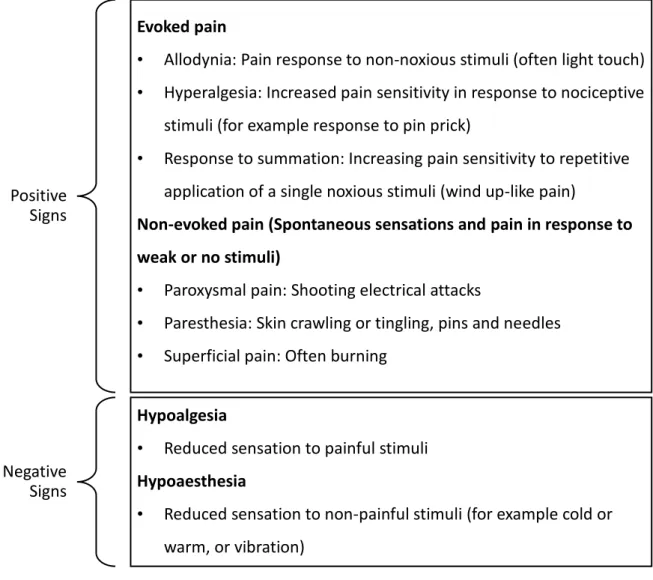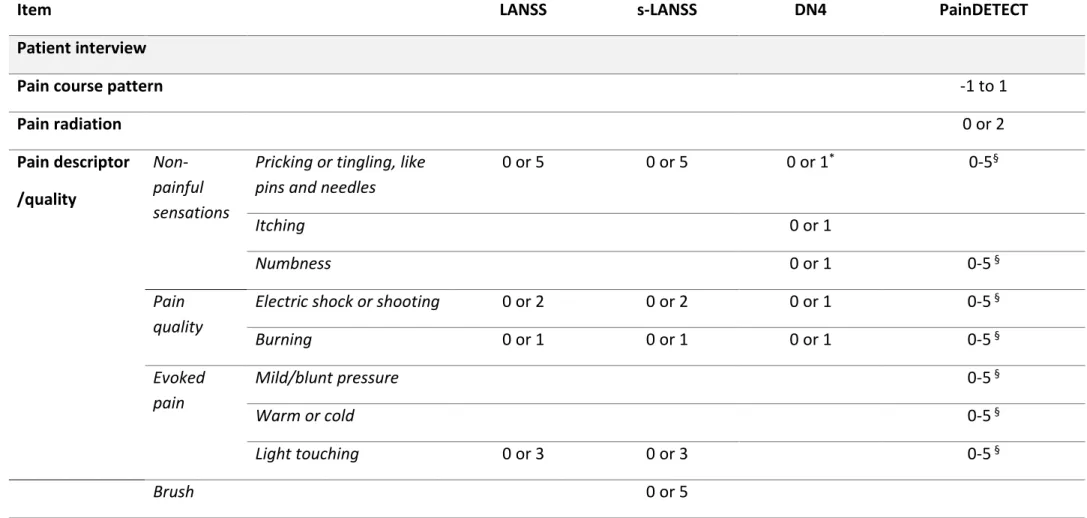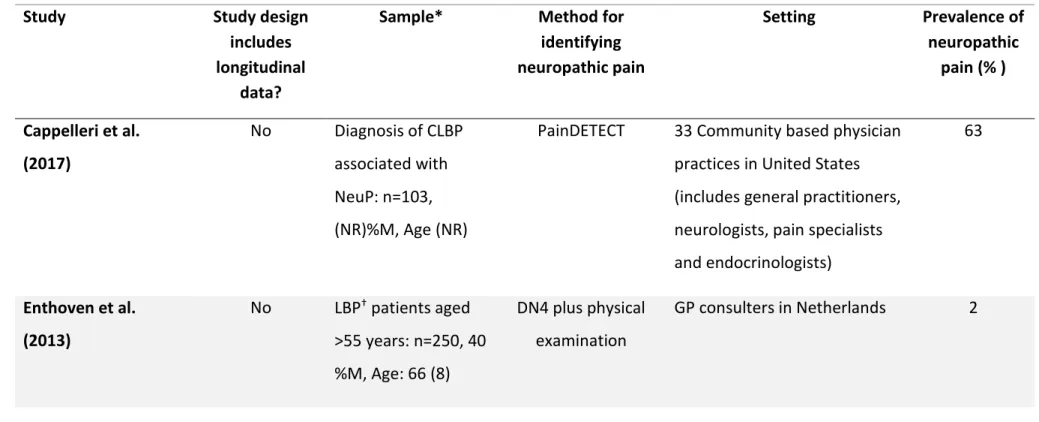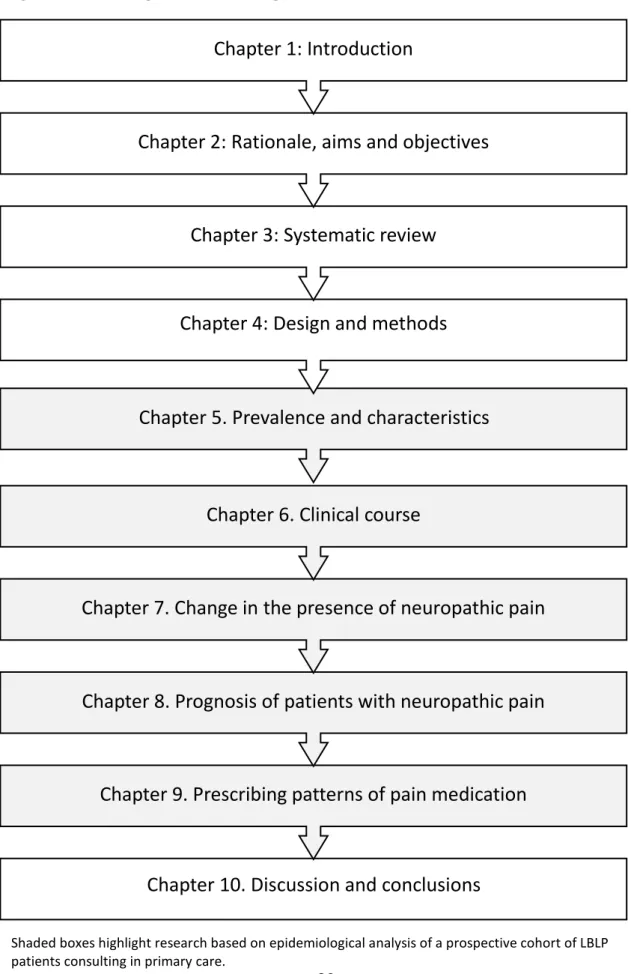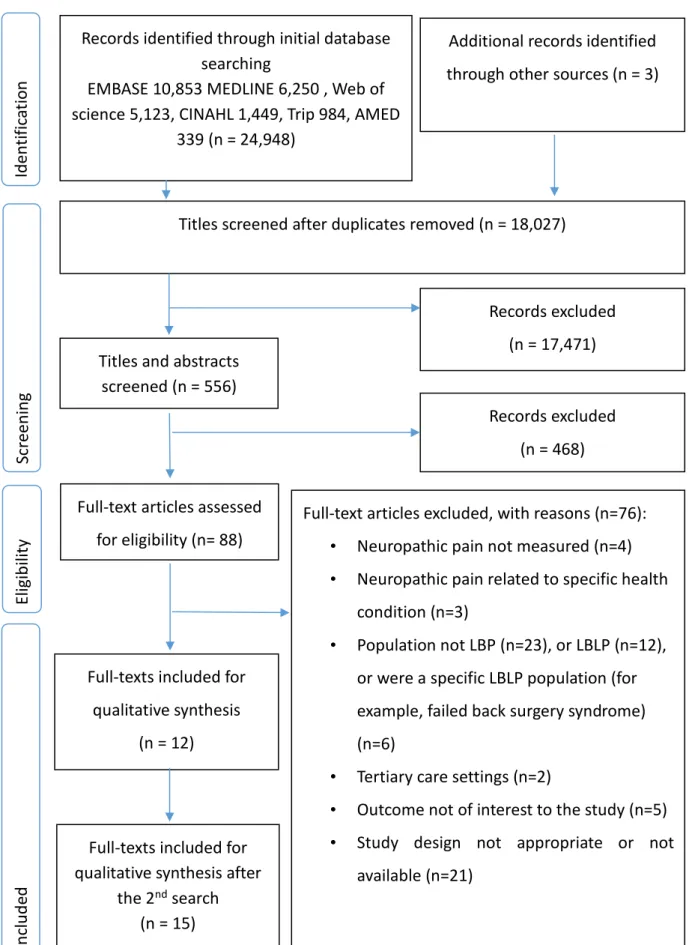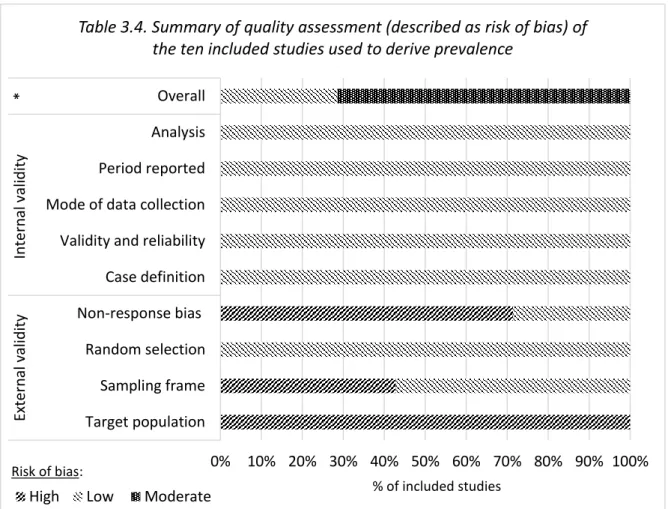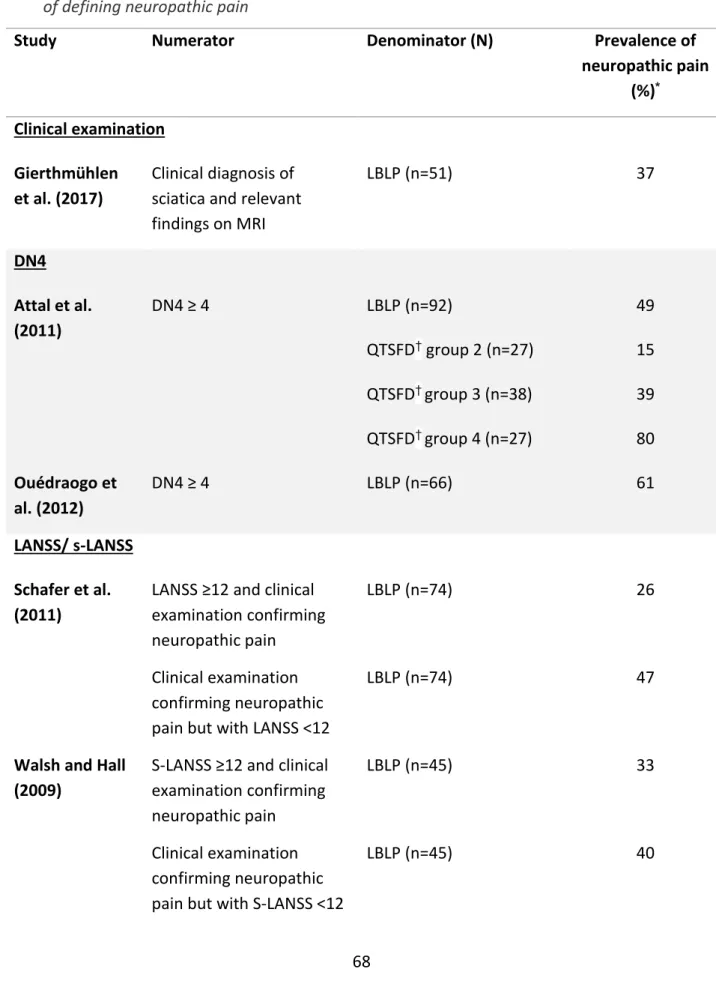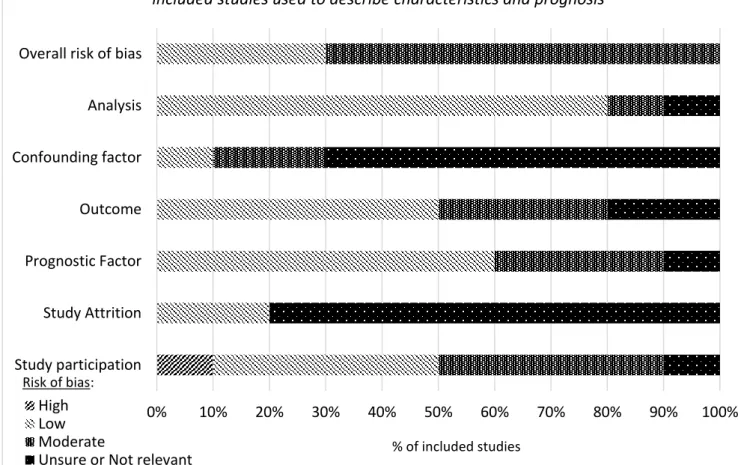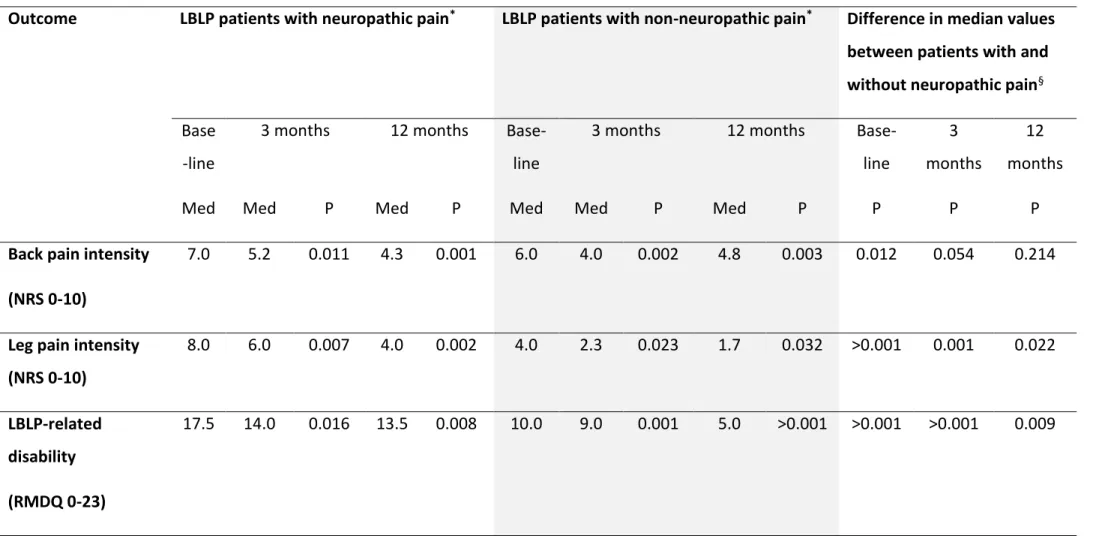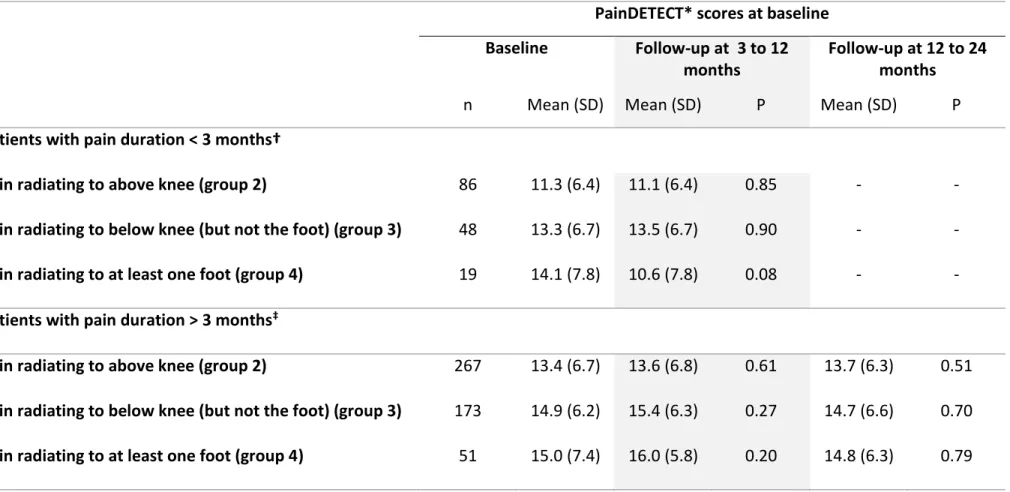duplicated by you for research, private study, criticism/review or educational purposes. Electronic or print copies are for your own personal, non-commercial use and shall not be passed to any other individual. No quotation
may be published without proper acknowledgement. For any other use, or to quote extensively from the work, permission must be obtained from the
Epidemiology of neuropathic pain in
primary care patients consulting with
low back-related leg pain
Sarah Anne Harrisson
A thesis submitted for the degree of Doctor of Philosophy
December 2018
Arthritis Research UK Primary Care Centre
Keele University
i
Declaration
This research in this thesis was nested in a prospective observational cohort study called the Assessment and Treatment of Leg pain Associated with the Spine (the ATLAS study) which was carried out at the Arthritis Research UK Primary Care Centre, Keele University. The idea for this study was developed by Dr Kika Konstantinou and Professor Kate Dunn who were both members of the main ATLAS research team and Professor Nadine Foster.
The objectives for the thesis were developed by myself with the support of my
supervisors, Kika Konstantinou, Kate Dunn, Dr Reuben Ogollah (statistical advisor) and Nadine Foster. I planned and conducted all the statistical analysis presented in this thesis with support and advice from my supervisors and in particular Reuben Ogollah. My supervisors gave advice and feedback on the writing in the chapters and on presentation of the data.
I undertook formal training in statistics and statistical software in advance of carrying out the statistical analysis by attending MSc Advanced Quantitative Data Analysis module (multivariable analysis) at Keele University and Stata Summer School
(advanced data management, graphics and medical statistics) held at CASS Business School, London. I attended formal epidemiology training at the UK Research in Musculoskeletal Epidemiology (UK-RIME) partnership Advanced Musculoskeletal Epidemiology Summer School (longitudinal analysis, missing data,
pharmacoepidemiology) held in Manchester and at the PROGRESS Summer School in prognosis research, Keele. The work in this thesis relates to an Education and
ii
Continued Professional Development (level 2) award by the Musculoskeletal
Association of Chartered Physiotherapists (MACP) to cover the cost of attending the UK-RIME Summer School.
Joanne Jordan and Dr Opeyemi Babatunde advised on searching strategies for the systematic review. Dr Siobhán Stynes independently reviewed abstracts, Siobhán Stynes, Kika Konstantinou and Kate Dunn independently reviewed full-texts and assisted with quality assessment of studies in the systematic review. Sarah Lawton facilitated the collection of data and Jenny Titley collected data from general practice electronic medical and prescribing records. Dr Julie Ashworth provided clinical advice on prescribing patterns of pain medications in primary care.
My doctoral studies were supported by a Clinical Doctoral Fellowship provided by National Institute for Health Research (NIHR) Research Professorship awarded to Nadine Foster (NIHR-RP-011-015).
iii
Abstract
Neuropathic pain (pain caused by nerve damage) is considered challenging to manage. One of the most common neuropathic pain conditions is believed to be the presence of sciatica in low back-related leg pain (LBLP). A systematic review of the literature highlighted a paucity of evidence on the prevalence, characteristics and prognosis of LBLP patients with neuropathic pain in primary care. Epidemiological analysis used an existing prospective cohort (n=609) of LBLP patients consulting in primary care, including items from routine clinical examination and self-report at baseline, plus general practice electronic medical and prescribing records of patients with
neuropathic pain. Cases of neuropathic pain were identified using three definitions, two based on clinical examination (with or without MRI), and one using the self-report Leeds Assessment for Neurological Symptoms and Signs (s-LANSS). Prevalence
estimates varied from 48% to 74% according to definition. At baseline, patients with neuropathic pain (across three definitions) had higher leg pain intensity, poorer pain self-efficacy, more had pain below the knee and sensory loss based on findings from routine neurological examination. The clinical course (pain intensity and LBLP-related disability) of patients with neuropathic pain rapidly improved up to four months after initial consultation; the extent of improvement depended on case definition. The presence of neuropathic pain changed over time, remaining persistent in 16% over three years. The clinical course of patients with persistent neuropathic pain was worse compared to those with non-persistent neuropathic pain; there was no evidence that neurological examination items were associated with persistent neuropathic pain at
iv
four months. Pain medication was commonly prescribed to patients with neuropathic pain; 30% were prescribed neuropathic pain medication, patients improved with and without such medication. This thesis provides new evidence that challenges some commonly held perceptions about neuropathic pain, with clear implications for clinical practice and future research.
v
Acknowledgements
There are many people to thank for support during my doctoral studies. I would especially like to thank my supervisors Kika Konstantinou, Kate Dunn, Reuben Ogollah and Nadine Foster for their committed supervision, invaluable advice and contribution to this thesis.
I would like to thank the following people for their contribution to specific aspects of this thesis; Joanne Jordan, Opeyemi Babatunde and Siobhán Stynes (systematic review), Sarah Lawton, Jenny Titley and Julie Ashworth (prescribing patterns of pain medications). During this programme of work I visited the Chronic Pain Research Group at University of Dundee, thank you to Professor Blair Smith and Dr Nicola Torrance, this visit was made possible by a Society of Back Pain Research (SBPR) Travel Fellowship. The Chartered Society of Physiotherapists (CSP) Charitable Trust awarded me a Conference and Presentation to attend the 6th International Congress on Neuropathic pain in Gothenburg, Sweden to present work from this thesis. This Doctoral programme was supported by NIHR and work in this thesis relates to an award by MACP. I gratefully appreciate the investment and opportunities given to me by CSP Charitable Trust, SBPR, NIHR and MACP.
I would also like to thank my family, friends and colleagues for their support and encouragement and finally, thank you to my husband Stuart for his support, encouragement and unfailing optimism and my children, Eliza and Campbell.
vii
Contents
Declaration ... i
Abstract ... iii
Acknowledgements ... v
List of Tables ... xvii
List of Figures ... xxi
List of Boxes ... xxiii
List of Abbreviations ... xxv
Published and presented work associated with this thesis ... xxvi
Awards associated with this thesis ... xxviii
Chapter One. Introduction ... 1
1.1 Overview of pain ... 1
1.1.1 Definition of pain ... 1
1.1.2 Nociceptive pain ... 2
1.1.3 Neuropathic pain ... 3
1.1.4 Pain from mixed mechanisms ... 6
1.1.5 Pain referral ... 7
1.2 Prognosis of pain in primary care ... 8
1.2.1 Primary care as a setting for research ... 9
1.3 Neuropathic pain ... 10
viii
1.3.2 Management of neuropathic pain ... 20
1.3.3 Epidemiology of neuropathic pain ... 21
1.4 Low back pain ... 24
1.4.1 Overview ... 24
1.4.2 Epidemiology of neuropathic pain in LBP patients ... 24
1.5 Low back-related leg pain ... 32
1.6 Summary ... 34
Chapter Two. Rationale, aims and objectives ... 35
2.1 Thesis rationale ... 35
2.2 Aims and Objectives ... 37
2.2.1 Objectives ... 37
2.3 Outline ... 38
2.4 Summary ... 42
Chapter Three. Neuropathic pain in low back-related leg pain: prevalence, characteristics and prognosis. A systematic review of the literature. ... 43
3.1 Introduction ... 43 3.2 Aims ... 43 3.3 Methods ... 44 3.3.1 Protocol registration ... 44 3.3.2 Search strategy ... 44 3.3.2 Study selection ... 46 3.3.3 Data extraction ... 47
3.3.4 Risk of bias (quality assessment) ... 48
ix 3.4 Results ... 50 3.4.1 Studies identified ... 50 3.4.2 Prevalence ... 65 3.4.3 Characteristics ... 70 3.4.4 Prognosis ... 97 3.5 Discussion ... 102 3.5.1 Prevalence ... 102
3.5.2 Characteristics and prognosis ... 103
3.5.3 Strengths and weaknesses ... 107
3.5.4 Implications for research and clinical practice ... 108
3.6 Conclusions ... 108
Chapter Four. Study design and methods ... 112
4.1 Introduction ... 112
4.2 Data source ... 112
4.3 Population of interest ... 112
4.4 Recruitment procedure and data collection ... 113
4.5 Clinical examination ... 116
4.6 Care pathways... 117
4.7 Case definitions of neuropathic pain ... 118
4.7.1 Definition based on a case ascertainment tool ... 118
4.7.2 Definition based on clinical diagnosis ... 119
4.8 Data management ... 119
4.9 Selected characteristics ... 120
x
4.9.2 Health status ... 122
4.9.3 Pain characteristics ... 123
4.9.4 Limitations in activities, participation and risk of persistent disability 126 4.9.5 Psychological characteristics and illness perceptions ... 128
4.9.6 Neurological examination ... 129
4.9.7 Neuroimaging ... 132
4.9.8 Health care use ... 134
4.10 Study sample ... 138
4.10.1 Completion of baseline data and clinical examination... 138
4.10.2 Response to follow-up ... 139
4.11 Missing data ... 148
4.11.1 Multiple imputation ... 148
4.12 Statistical software ... 149
4.13 Summary ... 150
Chapter Five. Prevalence and characteristics of neuropathic pain in primary care patients with low back-related leg pain ... 151
5.1 Introduction ... 151
5.2 Aims and objectives ... 151
5.2.1 Overall aim ... 151
5.2.2 Objectives ... 151
5.3 Methods ... 152
5.3.1 Study design ... 152
5.3.2 Neuropathic pain definitions ... 152
xi
5.4 Statistical analysis ... 158
5.5 Results ... 159
5.5.1 Prevalence of neuropathic pain ... 159
5.5.2 Characteristics of patients with neuropathic pain defined by s-LANSS 162 5.5.3 Characteristics of patients with neuropathic pain based on a clinical diagnosis of sciatica ... 175
5.5.4 Characteristics of patients with neuropathic pain based on a clinical diagnosis plus evidence of possible or clear nerve root compression on MRI185 5.5.5 Characteristics of patients with neuropathic pain across three definitions ... 196
5.6 Discussion ... 201
5.6.1 Prevalence ... 201
5.6.2 Baseline characteristics... 203
5.6.3 Strengths and limitations ... 209
5.6.4 Implications for clinical practice and research ... 210
5.7 Conclusions ... 212
Chapter Six. Clinical course of patients with and without neuropathic pain consulting in primary care with low back-related leg pain ... 214
6.1 Introduction ... 214
6.2 Aims and objectives ... 214
6.2.1 Overall aim ... 214
6.2.2 Objectives ... 214
6.3 Methods ... 215
6.3.1 Study design ... 215
xii
6.3.3 Measures of clinical course... 216
6.4 Statistical analysis ... 216
6.5 Results ... 217
6.5.1 Study population ... 217
6.5.2 Clinical course of pain intensity ... 219
6.5.3 Clinical course of leg and back pain-related disability... 223
6.6 Discussion ... 226
6.6.1 Strengths and limitations ... 229
6.6.2 Implications for clinical practice and research ... 230
6.7 Conclusions ... 231
Chapter Seven. Change in the presence of neuropathic pain in patients consulting in primary care with low back-related leg pain ... 232
7.1 Introduction ... 232
7.2 Aims and objectives ... 232
7.2.1 Overall aim ... 232
7.2.2 Objectives ... 233
7.3 Methods ... 233
7.3.1 Study design ... 233
7.3.2 Neuropathic pain definitions ... 234
7.3.3 Baseline characteristics... 234
7.4 Statistical analysis ... 238
7.4.1 Frequency of neuropathic pain in LBLP patients over baseline, short, intermediate and long-term time points ... 238
xiii
7.4.3 Missing data ... 239
7.5 Results ... 239
7.5.1 Study population ... 239
7.5.2 Frequency of neuropathic pain at baseline, short, intermediate and long term time points ... 239
7.5.3 Change in the presence of neuropathic pain in LBLP patients ... 240
7.5.4 Comparison of complete case analysis versus imputed data ... 253
7.6 Discussion ... 254
7.6.1 Strengths and limitations ... 257
7.6.2 Implications for clinical practice and research ... 258
7.7 Conclusions ... 259
Chapter Eight. Prognosis of LBLP patients with neuropathic pain: Characteristics, clinical course and prognostic factors ... 260
8.1 Introduction ... 260
8.2 Aims and objectives ... 261
8.2.1 Overall aim ... 261
8.2.2 Objectives ... 261
8.3 Methods ... 261
8.3.1 Study design ... 262
8.3.2 Data collection ... 262
8.3.3 Neuropathic pain definitions ... 262
8.3.4 Measures ... 263
8.4 Statistical analysis ... 266
xiv
8.4.2 Clinical course ... 266
8.4.3 Exploratory prognostic factor research ... 266
8.5 Results ... 271
8.5.1 Baseline characteristics... 271
8.5.2 Clinical course ... 281
8.5.3 Identification of potential prognostic factors ... 287
8.5.4 Prognostic value of selected factors ... 291
8.6 Discussion ... 294
8.6.1 Baseline characteristics and clinical course ... 294
8.6.2 Exploratory prognostic factor research ... 295
8.6.3 Strengths and limitations ... 301
8.6.4 Implications for clinical practice and research ... 302
8.7 Conclusions ... 303
Chapter Nine. Prescribing patterns of pain medications in LBLP patients with neuropathic pain ... 305
9.1 Introduction ... 305
9.2 Aims and objectives ... 306
9.2.1 Overall aim ... 306
9.2.2 Objectives ... 306
9.3 Methods ... 306
9.3.1 Study design ... 306
9.3.2 Data collection ... 307
9.3.3 Definitions of neuropathic pain, refractory neuropathic pain and improvement ... 308
xv
9.3.4 Baseline characteristics and consultations in primary care ... 309
9.4 Statistical analysis ... 313
9.4.1 Patterns of pain medication prescriptions ... 313
9.4.2 Baseline characteristics and consultations in primary care ... 313
9.4.3 Estimates of LBLP patients with refractory neuropathic pain ... 314
9.5 Results ... 315
9.5.1 Patterns of pain medication prescriptions ... 315
9.5.2 Baseline characteristics of patients with neuropathic pain prescribed neuropathic pain medication... 321
9.5.3 Prescribed medications and proportion of patients with neuropathic pain with improvement four months after index consultation at ATLAS research clinic ... 327
9.5.5 Estimates of LBLP patients with refractory neuropathic pain ... 330
9.6 Discussion ... 330
9.6.1 Prescribing patterns of pain medications in LBLP patients with neuropathic pain ... 331
9.6.2 Characteristics of patients prescribed neuropathic pain medication .. 334
9.6.3 Refractory neuropathic pain ... 337
9.6.4 Strengths and limitations ... 340
9.6.5 Implications for clinical practice and research ... 342
9.7 Conclusions ... 343
Chapter Ten. Discussions and conclusions ... 345
10.1 Key findings ... 347
10.3 Strengths and limitations of the thesis ... 356
xvi
10.5 Implications for future research ... 362
10.6 Conclusions ... 364
References ... 366
Appendix A Supplementary data for Chapter Three ... 393
Appendix A1 Full systematic search strategy ... 393
Appendix A2 Data extraction tool ... 408
Appendix A3 Flow chart of the 2nd systematic search and study selection .. 416
Appendix A4 Results of quality appraisal ... 417
Appendix B Supplementary data for Chapter Seven: analysis based on imputed data ... 421
Appendix C Supplementary data for Chapter Nine: analysis based on imputed data ... 431
xvii
List of Tables
Chapter One
Table 1.1 Comparison of methodology used in neuropathic pain case ascertainment tools………16
Table 1.2 Comparison of sensory descriptors, physical tests and scoring in
neuropathic pain case ascertainment tools………..18 Table 1.3 Characteristics of studies showing prevalence of neuropathic pain in low back pain, grouped by setting in primary care or mixed setting (primary and, or secondary and, or tertiary care)………..26 Chapter Three
Table 3.1 Details of electronic databases searched……….45 Table 3.2 Eligibility criteria for study selection………46 Table 3.3 Summary of all fifteen studies included in the systematic review…….56 Table 3.4. Summary of quality assessment (described as risk of bias) of the ten included studies used to derive prevalence………..67 Table 3.5 Studies showing prevalence of neuropathic pain, grouped by method of defining neuropathic pain………...69 Table 3.6. Summary of quality assessment (described as risk of bias) of the eleven included studies used to describe characteristics and prognosis…………..73
Table 3.7 Studies showing characteristics of neuropathic pain………82 Table 3.8 Study by Morsø et al. (2011) showing overall prognosis of neuropathic pain in low back-related leg pain (n=145) ………..……101
Table 3.9 Study by Hüllemann et al. (2017) showing change in the presence of neuropathic pain in low back-related leg pain………..…..103
xviii Chapter Four
Table 4.1 Differentiating signs and symptoms of sciatica and referred leg pain ………117 Table 4.2 Neuropathic pain definitions based on clinical diagnosis………..119 Table 4.3 Categorisation of pain medications in this thesis……….……137 Table 4.4 Baseline characteristics of participants followed-up and lost to follow-up……….141 Chapter Five
Table 5.1 Summary of key characteristics used to describe patients with neuropathic pain medication in research in Chapter five……….…154
Table 5.2 Prevalence of neuropathic pain in patients based on three case
definitions..………160 Table 5.3 Baseline characteristics of patients with neuropathic pain based on s-LANSS……….166 Table 5.4 Baseline characteristics of patients with neuropathic pain defined by clinical diagnosis of sciatica………177 Table 5.5 Baseline characteristics of patients with neuropathic pain based on a clinical diagnosis of sciatica and evidence of nerve root compression on MRI.187 Chapter Six
Table 6.1 Treatment (care pathway) received by patients across three definitions of neuropathic pain………..220
Chapter Seven
Table 7.1 Summary of key characteristics used to describe patients in research in Chapter seven………..237
xix
Table 7.2 Change in the presence of neuropathic pain in patients over a three-year follow-up period……….………244
Table 7.3 Proportion of patients by neuropathic pain sub-group (n=199)………247 Table 7.4 Baseline characteristics of patients by neuropathic pain sub-group over three-years (n=199) ………249 Table 7.5 Evidence of nerve root compression across neuropathic pain sub-groups comparing imputed data and data using complete cases………256
Chapter Eight
Table 8.1 Summary of key characteristics used to describe patients with persistent neuropathic pain in research in Chapter eight……….267
Table 8.2 Selected potential prognostic factors………..273 Table 8.3 Baseline characteristics of patients with and without persistent
neuropathic pain (based on s-LANSS) ………275 Table 8.4 Baseline characteristics of patients with and without persistent
neuropathic pain (based on a clinical diagnosis of sciatica) ………..279 Table 8.5 Univariable associations between potential prognostic factors and persistent neuropathic pain at four months (based on s-LANSS) ………..292 Table 8.6. Univariable associations between potential prognostic factors and
persistent neuropathic pain at four months (based on a clinical diagnosis of sciatica) ………294
Table 8.7 Multivariable associations between potential prognostic factors and persistent neuropathic pain at four months (based on s-LANSS)………296 Table 8.8 Multivariable associations between potential prognostic factors and persistent neuropathic pain at four months (based on a clinical diagnosis of sciatica) ………297
xx Chapter Nine
Table 9.1 Summary of groups of pain medication in research in Chapter nine.311 Table 9.2 Summary of key characteristics used to describe patients with neuropathic pain medication in research in Chapter nine………313
Table 9.3 Pain medication prescribed in primary care for patients with neuropathic pain (for three definitions) up to four months before and after index
consultation………321
Table 9.4 Pain medication prescribed in primary care for patients with neuropathic pain (based on s-LANSS) up to four months before and three years after index consultation………324
Table 9.5 Baseline characteristics of patients with neuropathic pain (based on s-LANSS) by neuropathic pain medication prescribedfour months before and after index consultation.………326 Table 9.6 Proportion of patients with neuropathic pain (based on s-LANSS) who improved by the number of neuropathic pain medications prescribed, comparing imputed data and data using complete cases……….332
Chapter Ten
Table 10.1 Symptoms of anxiety and depression for neuropathic pain sub-groups over three years……….356
xxi Chapter One
Figure 1.1 Key features of positive and negative signs of neuropathic pain…….…4 Figure 1.2 Updated hierarchical classification system for patients with neuropathic pain. Reproduced with permission from Walters Kluwer Health (Finnerup et al. 2016) ……….….11
Chapter Two
Figure 2.1 Flow diagram summarising thesis structure……….39 Figure 2.2 Outline of chapters in this thesis………..40 Chapter Three
Figure 3.1. Flow chart of systematic search and study selection (adapted from the PRISMA flow chart) (Moher et al., 2009) ………..………52 Chapter Four
Figure 4.1 ATLAS study flow diagram (adapted from Konstantinou et al. (2015)) ………115 Chapter Five
Figure 5.1 Neuropathic pain definitions, grouped by certainty of definition.….152 Figure 5.1 Venn diagram depicting the overlap between LBLP patients with and without neuropathic pain at baseline based on three definitions………….……….160 Figure 5.2 Characteristic associated with only one definition of neuropathic pain.. ……….198
xxii
Figure 5.4 Characteristics consistently associated with neuropathic pain across three definitions and characteristics that were similar between the two groups.
………200 Figure 5.5 Summary of pain medication use in patients with and without
neuropathic
pain……….201 Chapter Seven
Figure 7.1 Proportion of patients with neuropathic pain at baseline and at three subsequent follow-up time-points (shown as patients who responded to follow-up) ………..242 Chapter Eight
Figure 8.1 Summary of baseline characteristics for patients with and without persistent neuropathic pain across two definitions……….………….……284 Chapter Nine
Figure 9.1 Bar chart showing proportion of patients with a clinically important difference in leg pain intensity and/or leg and back pain-related disability by four months………..………331 Chapter Ten
xxiii Chapter Six
Box 6.1 Three year clinical course (mean pain intensity) of patients with and without neuropathic pain (based on s-LANSS) at baseline………..222
Box 6.2 Three year clinical course (mean pain intensity) of patients with and without neuropathic pain (based on a clinical diagnosis of sciatica) at baseline.
………223 Box 6.3 Three year clinical course (mean pain intensity) of patients with and without neuropathic pain (based on a clinical diagnosis of sciatica with evidence of nerve root compression) at baseline……….224
Box 6.4 Three year clinical course (leg and back pain-related disability) of patients with and without neuropathic pain (based on s-LANSS) at baseline…226
Box 6.5 Three year clinical course (leg and back pain-related disability) of patients with and without neuropathic pain (clinical diagnosis of sciatica) at
baseline………227 Box 6.6 Three year clinical course (leg and back pain-related disability) of patients with and without neuropathic pain (clinical diagnosis of sciatica with evidence of nerve root compression) at baseline………..228
Chapter Eight
Box 8.1 Criteria for investigating prognostic factors……….………272 Box 8.2 Three year clinical course (pain intensity) of LBLP patients with and without persistent neuropathic pain (based on s-LANSS) at four months………286
Box 8.3 Three year clinical course (leg and back pain-related disability) of LBLP patients with and without persistent neuropathic pain (based on s-LANSS) at four months………..…287
xxiv
Box 8.4 Three year clinical course (pain intensity) of LBLP patients with and without persistent neuropathic pain (based on a clinical diagnosis of sciatica) at four
months………..…289 Box 8.5 Three year clinical course (leg and back pain-related disability) of LBLP patients with and without persistent neuropathic pain (based on a clinical diagnosis of sciatica) at four months………290
xxv
ATLAS Assessment and Treatment of Leg pain Associated with the Spine Study CI Confidence interval (95%)
BMI Body mass index (Kg/m2)
GP General Practitioner
HADS Hospital Anxiety and Depression Scale
IASP International Association for the Study of Pain IPQ-R Musculoskeletal Illness Perceptions Questionnaire MRI Magnetic Resonance Imaging
MRR Medical Records Review
N Number
NeuPSIG Neuropathic Pain Special interest Group of IASP NICE The National Institute for Health and Care Excellence NSAID Non-steroidal anti-inflammatory medication
NHS National Health Service NRS Numerical rating scale
OR Odds ratio
PSEQ Pain Self-Efficacy Questionnaire
RMDQ Roland Morris Disability Questionnaire SD Standard deviation
s-LANSS Self-report version of Leeds Assessment of Neuropathic Symptoms and Signs
xxvi
Research articles
Harrisson, S. A. Stynes, S. Dunn, K. M. Foster, N. E. Konstantinou, K. Neuropathic Pain in Low Back-Related Leg Pain Patients: What Is the Evidence of Prevalence,
Characteristics, and Prognosis in Primary Care? A Systematic Review of the Literature. J Pain. 2017 Nov; 18 (11):1295-1312
Published protocols
Harrisson, S. A. Stynes, S. Dunn, K. M. Foster, N. E. Konstantinou, K. Neuropathic pain in patients with low back pain and leg pain: prevalence, characteristics, clinical course and prognostic indicators: a systematic review of the literature. PROSPERO 2015 CRD42015023388 Available from:
http://www.crd.york.ac.uk/PROSPERO/display_record.php?ID=CRD42015023388
Published abstracts
Harrisson, S. A. Ogollah R. Dunn, K. M. Foster, N. E. Konstantinou, K. Prevalence and characteristics of neuropathic pain in primary care patients with low back-related leg pain. Bone Joint Res. Feb 2018. 99-B (Supp 10):16
Work presented
Harrisson, S. A. Epidemiology of neuropathic pain in primary care patients consulting with low back-related leg pain. BritSpine, Leeds, March 2018.
Harrisson, S. A. Ogollah R. Dunn, K. M. Foster, N. E. Konstantinou, K. Primary care patients with low back-related leg pain: identification of cases with persistent neuropathic pain. Society for Back Pain Research Annual Meeting, November 2017.
xxvii
Harrisson, S. A. Ogollah R. Dunn, K. M. Foster, N. E. Konstantinou, K. Low back-pain related leg pain patients in primary care: Identifying change in the presence of
neuropathic pain. XV International Back and Neck Pain Forum, Oslo, September 2017. Harrisson, S. A. Ogollah R. Dunn, K. M. Foster, N. E. Konstantinou, K. Is the clinical course of patients with low back-related leg pain with neuropathic pain worse compared to those without? 6th International Congress on Neuropathic pain,
Gothenburg, June 2017.
Harrisson, S. A. Change in the presence of neuropathic pain over time in patients with low back related leg pain consulting in primary care. Keele University Research
Institute of Primary care and Health Sciences Postgraduate Symposium, May 2017. Harrisson, S. A. Is the clinical course of patients with low back-related leg pain with neuropathic pain worse compared to those without? Keele University Institute for Liberal Arts and Sciences: Crossing paths conference, April 2017.
Harrisson, S. A. Ogollah R. Dunn, K. M. Foster, N. E. Konstantinou, K. Prevalence and characteristics of neuropathic pain in primary care patients with low back-related leg pain. Society for Back Pain Research Annual Meeting, Preston, November 2016. Harrisson, S. A. Stynes, S. Dunn, K. M. Foster, N. E. Konstantinou, K. Neuropathic pain in primary care patients with low back and leg pain: prevalence, characteristics and prognosis. A systematic review of the literature. XIV International Back and Neck Pain Forum, Buxton, May 2016.
Harrisson, S. A. Epidemiology of neuropathic pain in patients with low back-related leg pain: A systematic review of the literature and development of a doctoral study. Keele University Research Institute of Primary care and Health Sciences Postgraduate
xxviii
Awards associated with this thesis
Winning presentation. Keele University Research Institute of Primary care and Health Sciences Postgraduate Symposium, May 2017
Selected to work with the Marketing and Communication department to produce a short video presentation. Keele University Institute for Liberal Arts and Sciences: Crossing paths conference, April 2017.
Early Career Researcher first place poster presentation. XIV International Back and Neck Pain Forum, Buxton, May 2016.
1
The research in this thesis is concerned with the epidemiological study of neuropathic pain in patients with low back-related leg pain (LBLP) consulting in primary care. In order to assist the reader in understanding the rationale for this focus, this first chapter outlines the current understanding of causal mechanisms underlying
nociceptive and neuropathic pain. Methods of assessing and diagnosing neuropathic pain are briefly discussed and case ascertainment tools appropriate for use in both epidemiological research and primary care are presented and discussed. A section outlines the principles of epidemiology in primary care and the advantages of choosing primary care as a setting for prognostic research. The chapter summarises the
literature on the frequency of neuropathic pain in the general population and heterogeneous populations of chronic pain. The penultimate section outlines the prevalence, characteristics and prognosis of neuropathic pain in low back pain (LBP) reported in the literature before the final section outlines the distinction between LBP and LBLP. A discussion is presented in the final section on the clinical diagnoses and underlying pain mechanisms related to LBLP.
1.1 Overview of pain
1.1.1 Definition of painThe International Association for the Study of Pain (IASP) Task Force on Taxonomy, edited by Merskey and Bogduk (1994) define pain as:
2
An unpleasant sensory and emotional experience associated with actual or potential tissue damage, or described in terms of such
damage.
The perception of pain is entirely subjective. Pain is always an unpleasant experience and is considered a psychological state (Merskey and Bogduk 1994).
1.1.2 Nociceptive pain
The term nociceptive pain is used to describe pain in a normally functioning
somatosensory nervous system (Merskey and Bogduk 1994) where somatosensory refers to sensation (such as pain, pressure or warmth) which can occur anywhere within the body including the visceral organs, but not external to the body (for example, vision, hearing, olfaction). Not all activity in the nociceptors and in the nociceptor pathway result in pain, because a noxious stimuli has to be perceived psychologically to be painful. The following section will present an overview of some of the mechanisms of nociceptive pain that are important for the purpose of this thesis.
1.1.2.1. Mechanisms of nociceptive pain
After an injury, both thin (pain) and thick (touch, pressure and vibration) nerve fibres carry impulse signals from the site of injury to the dorsal horn of the spinal cord. At the dorsal horn, the impulse is transmitted through ascending tracts in the spinal column to the brain where the pain is perceived in the thalamus; this may trigger a descending signal to the area of injury which in turn may result in modulation of cell activity and the experience of pain. The perception of pain at any one time depends in part on the
3
previous experiences of the individual, the context in which they received the injury, and the current state of the individual’s mood. Activity in both the thin and thick nerve fibres is important to consider because they have different roles in the transmission of pain signals. In a normal state, thin fibre activity tends to result in the transmission of signals to the brain whereas thick fibre activity tends to result in reduction of
transmission, the more the thick (vibration, touch and pressure) fibre activity the less pain is perceived.
1.1.3 Neuropathic pain
Nociceptive pain is considered to be an adaptive process which differs from
neuropathic pain which is considered maladaptive. Neuropathic pain is defined by the Neuropathic Pain Special Interest Group of the International Association for the Study of Pain (IASP) (Treede et al. 2008) as:
Pain arising as a consequence of a lesion or disease of the somatosensory system.
A lesion reflects abnormalities when there is trauma or injury (for example, spinal cord transection) and a disease is commonly used when the cause for the underlying lesion is known (for example, stroke, cancer or diabetes mellitus) (Merskey and Bogduk 1994). Neuropathic pain is a sub-group of neurogenic pain (Merskey and Bogduk 1994) and the implication of this is that neuropathic pain is irreversible. Patients with clinical conditions characterised by neuropathic pain may report symptoms such as electrical attack-like pain which are particularly distressing. Unlike in nociceptive pain,
4
neuropathic pain is characterised by spontaneous (non-evoked) pain such as electrical attacks or pins and needles (this is an example of a positive sign of neuropathic pain) and also a loss of function (also known as negative signs) (Baron et al. 2010). Figure 1.1 summarises the key features of both positive and negative signs. The pain system is not considered static and as such, the signs and symptoms of neuropathic pain may change during the course of the disease (Jensen and Baron 2003).
Figure 1.1 Key features of positive and negative signs of neuropathic pain
Evoked pain
• Allodynia: Pain response to non-noxious stimuli (often light touch) • Hyperalgesia: Increased pain sensitivity in response to nociceptive
stimuli (for example response to pin prick)
• Response to summation: Increasing pain sensitivity to repetitive application of a single noxious stimuli (wind up-like pain)
Non-evoked pain (Spontaneous sensations and pain in response to weak or no stimuli)
• Paroxysmal pain: Shooting electrical attacks
• Paresthesia: Skin crawling or tingling, pins and needles • Superficial pain: Often burning
Positive Signs
Negative Signs
Hypoalgesia
• Reduced sensation to painful stimuli Hypoaesthesia
• Reduced sensation to non-painful stimuli (for example cold or warm, or vibration)
5
1.1.3.1 Mechanisms of neuropathic pain
In the event of an injury or lesion to the somatosensory system, a number of events occur both local to the site of injury and centrally in response to the injury. As with the mechanisms of nociceptive pain, an understanding of how mechanisms generate symptoms in neuropathic pain is important for the purpose of this thesis and an outline of mechanisms is provided in the discussion below. Further details can be found in a review on Neuropathic pain by Cohen and Mao (2014). At the site of a lesion, demyelination and cell death can lead to both positive and negative signs of neuropathic pain. Positive signs such as spontaneous pain are generated in part by abnormal impulse generation and electrical hyperexcitability (called ectopic
excitability) at the site of injury (Devor 2013), and negative signs can result from loss of function because of a reduction in impulse conduction (Woolf 2004). Ectopic
excitability in peripheral nerves contributes to neuropathic pain in two ways, firstly, it directly drives pain pathways in the central nervous system and secondly, it can trigger and maintain increased sensitivity of neurons in the central nervous system to normal or subthreshold peripheral nerve activity (also called central sensitisation) (Devor 2013).
Central sensitisation is not exclusive to neuropathic pain; in both neuropathic and nociceptive pain conditions, changes in the spinal cord and in the higher centres of the brain are in part, characterised by an amplification of pain. Amplification arises when thick nerve fibres that normally do not produce pain undergo a change in cellular characteristics that results in normally non-noxious stimuli being perceived as noxious
6
(described as allodynia) (Devor 2013). This process by which the nerve changes its function is synonymous with alterations in gene expression and is described as a phenotypic switch. The phenotypic switch in this case brings about a change in cellular characteristics that increases the expression of inflammatory mediators (Cohen and Mao 2014). The following section (1.1.4) outlines the role of inflammatory mediators in both neuropathic and nociceptive pain mechanisms, and then section 1.1.5 outlines how sensitisation at the level of the spinal cord contributes to the phenomena of referred pain.
1.1.4 Pain from mixed mechanisms
The mechanisms underlying nociceptive and neuropathic pain involve inflammatory pain responses (Devor 2013). The role of inflammation in nociceptive pain is
considered to be a necessary part of the healing process in the acute stages, and these mechanisms are well established (Bennett 2006). In neuropathic pain conditions, where nerve damage causes inflammation and also inflammation causes ongoing nerve damage, the underlying process is less clear (Bennett 2006). Conceptually and in terms of clinical application it is difficult to make a clear distinction between
neuropathic and inflammatory pain (Bennett 2006). In fact, inflammatory pain, neuropathic pain and nociceptive pain often co-exist. A space occupying tumour can simultaneously apply noxious force on adjacent healthy tissue (nociceptive pain), directly injure nerves (neuropathic pain) and trigger an inflammatory response (Devor 2013). The presence of one type of pain does not infer the absence of the other type of pain and the three clinically co-exist together.
7 1.1.5 Pain referral
Referred pain is that perceived in a region topographically distinct from the region in which the actual pain source is located, is thought to be caused by amplification of neurons in the spinal cord and is assumed to be non-neuropathic in nature (Merskey and Bogduk 1994). Referred pain can occur in both somatic tissue and visceral tissue, a common example in somatic tissue is the self-report of buttock or leg pain arising from degenerative changes in the facet joints. In this example, pain referred to the buttock or leg may be caused by convergent inputs to spinal cord neurons receiving inputs from sensory neurons of the facet joints as well as the remote tissues of the leg or buttock (Treede et al. 1992). In the example given of facet joint degeneration, the location of the remote pain in the leg is associated with the intensity and duration of the activation of the sensory inputs from the facet joint.
The classical view of the natural history of patients with nociceptive pain is that of a favourable prognosis whereas that of patients with neuropathic pain appears different, with many people with neuropathic pain often living with persisting pain (Ciaramitaro et al. 2010). This chapter now proceeds to discuss some of the key concepts of
prognosis research in pain, and then the relevance of settings in pain research (Section 1.2). This is before section 1.3 which provides an outline of the methods commonly used to assess neuropathic pain in clinical practice and in epidemiological research, and an outline of how neuropathic pain is currently managed in clinical practice before presenting the epidemiology of neuropathic pain in common clinical conditions.
8
1.2 Prognosis of pain in primary care
The term “prognosis” refers to the risk of future health outcomes in people with a particular disease or health condition, in the context of this thesis the health condition is neuropathic pain. The prognosis of patients with neuropathic pain is thought to be worse than those with nociceptive pain. Overall prognosis research answers questions such as, “what is the most likely course of this patient with this health condition”. In patients who consult with health care professionals, overall prognosis describes the clinical course rather than natural history of a condition as it takes into consideration that a patient would have undergone some form of diagnostic assessment with a treatment plan. To improve the likely clinical course of patients with neuropathic pain, evidence is required on whether specific characteristics (prognostic factors) are
associated with future endpoints such as neuropathic pain-related disability or persistence of pain (Hemingway et al. 2013). Information comes from prospective observational studies where the temporal relation between a prognostic factor and given endpoint can be investigated. A prognostic factor is defined as a biological, behavioural, symptomatic, psychological or environmental measure that can be modifiable (for example body mass index) or non-modifiable (for example family history) and is associated with a future outcome (Riley et al. 2013). Prognosis research informs clinicians and patients on an individual level and provides valuable information for public health policy (Hemingway et al. 2013).
9 1.2.1 Primary care as a setting for research
The setting in which pain is studied is crucial to the questions posed and the interpretation of prognosis research findings. The first point of contact for an
individual with pain entering the health care system in the UK is usually a primary care provider (Costa Lda et al. 2013) such as a general practitioner, or other clinicians such as practice nurses, physiotherapists or osteopaths. The majority of patients with pain are managed in primary care rather than in specialist pain centres (Breivik et al. 2006). In the current literature on pain, specialist pain services have been used extensively to provide access to large numbers of patients for research. It is likely that populations of patients drawn from specialist pain services are systematically different than patients consulting in primary care which limits the generalisability of research findings
(Crombie and Davies 1998). Epidemiological studies that draw from primary care rather than specialist pain settings have key advantages. One advantage is that
estimates of prevalence and characteristics of a condition of interest are likely to more accurately reflect the problem in the general population than studies in set in specialist pain centres (Tager 1998). The epidemiology of neuropathic pain in primary care is important for many reasons. It provides valuable information on the prevalence, characteristics in terms of symptom duration, and severity of neuropathic pain within a condition. Such evidence may be very useful in developing better management
10
1.3 Neuropathic pain
1.3.1 Assessment of neuropathic pain
Neuropathic pain is a clinical description (and not a diagnosis) (Merskey and Bogduk 1994). Detecting neuropathic pain can present with difficulties. There is not one sign or symptom that is exclusively attributed to neuropathic pain, nor is there absolute consensus on how patients with neuropathic pain should be identified in clinical practice or epidemiological research. This section discusses how, in the absence of a gold standard, patients with neuropathic pain are commonly identified in both clinical practice and for the purposes of epidemiological research. A number of neuropathic pain case ascertainment tools that are commonly cited in the neuropathic pain literature are described in section 1.3.1.2 and are summarised in Tables 1.2 and 1.3.
1.3.1.1 Assessment using clinical examination
There is some consensus that in clinical practice, patients with neuropathic pain are identified by clinical history and examination (Treede et al. 2008). The Neuropathic Pain Special Interest Group of IASP proposed a hierarchical classification system with four criteria based on clinical examination and confirmatory tests (Treede et al. (2008) updated by Finnerup et al. (2016)). Figure 1.2 reproduces the updated grading system reported by Finnerup et al. (2016).
11
*The area of sensory changes may extend beyond the innervation territory. Neurological examination may include sensory examination of touch, vibration, pin-prick, cold and/or warm. Sensory loss is generally required to be present for patients to meet criterion of “probable” neuropathic pain.
In specialist pain settings, clinical history and an extensive neurological examination may identify patients at best as having “probable” neuropathic pain, additional confirmatory tests may identify patients with “definite” neuropathic pain but despite investigations the cause of the pain often remains unknown (Cruccu and Truini 2009).
Pain
History of relevant neurological lesion or disease and pain distribution neuro-anatomically plausible
Pain is associated with sensory signs in the same neuro-anatomically plausible distribution*
Diagnostic test confirming a lesion or disease of the somatosensory nervous system explaining the pain
Possible neuropathic pain Probable neuropathic pain Definite neuropathic pain Unlikely to be neuropathic pain Leading complaint History Examination Confirmatory tests Yes Yes Yes
12
In primary care where clinicians are non-specialists, patients would be identified at best as having “possible” neuropathic pain. It is questionable whether forms of assessment that are offered in specialist pain settings are clinically useful in settings such as primary care where the majority of patients with neuropathic pain are managed (Breivik et al. 2006). In epidemiological research too, a more detailed assessment other than clinical examination is generally unattainable (Smith and
Torrance 2010). Questionnaires or case ascertainment tools potentially provide benefit to the clinician by facilitating early diagnosis and decision-making about appropriate treatment. Academically, questionnaires allow for population-based epidemiological studies and clinical trials (Smith and Torrance 2010). Simple tools have been developed for use in research and in clinical practice where complex and time consuming
methods of assessment are not possible.
1.3.1.2 Assessment using neuropathic pain case ascertainment tools
This section provides a description of neuropathic pain case ascertainment tools commonly cited in the published literature. Case ascertainment tools for the purposes of epidemiological study in neuropathic pain need to detect features of pain that are characteristically neuropathic in an efficient, valid and reliable manner (Smith and Torrance 2010). One of the first tools to use sensory descriptors of neuropathic pain was the McGill Pain Questionnaire (Boureau et al. 1992). It identifies six sensory descriptors that are more commonly used by patients with neuropathic pain, these were: “electric shock”, “burning”, “cold”, “pricking”, “tingling” and “itching”. These six
13
descriptive words have been used in a number of subsequent tools that attempt to screen and identify cases of neuropathic pain.
These tools include: the Leeds Assessment of Neuropathic Symptoms and Signs
(LANSS) (Bennett 2001), the Douleur Neuropathique en 4 questions (DN4) (Bouhassira et al. 2005), painDETECT (Freynhagen et al., 2006), Neuropathic Pain Questionnaire (Krause and Backonja 2003) and ID Pain (Portenoy 2006). All have been adapted for use in a number of languages, neuropathic pain disorders (i.e. diabetic neuropathy, radicular pain/sciatica, and trigeminal neuropathy) and health care settings and at best describe patients with “possible” neuropathic pain (Smith et al. 2012a). The LANSS, PainDETECT and DN4 have been used in populations relevant to low back pain (for example, Walsh et al. (2012) and Beith et al. (2011)). LANSS was subsequently
developed into a self-report version, the s-LANSS (Bennett et al. 2005). Each of these tools are presented in more detail below, the methodology used in the development of each tool is considered in Table 1.1, and the reported sensory and physical items and scoring is reported and compared in Table 1.2.
1.3.1.2.1 LANSS and s-LANSS
LANSS (Bennett, 2001) was developed in two populations with chronic pain, and consists of a seven-item pain scale including five sensory descriptors and two items of clinical examination with a simple, weighted scoring system. Clinical diagnosis was classified by one clinician based on clinical features, known pathology, and radiological or electro-physical evidence. The tool was then validated in a second group of patients with nociceptive and neuropathic pain (known pathology of mixed origin) (n=40)
14
(Bennett, 2001). A score of 12 or more (out of a possible 24) suggests neuropathic pain. Further research has led to the development of a self-report, self-examination of the LANSS (Bennett et al., 2005), known as s-LANSS. Individual items of s-LANSS reported the following changes: dysesthesia, autonomic (for example, red mottled changes to the skin), evoked, paroxysmal, thermal, allodynia and tenderness or numbness. S-LANSS has also been used in back pain populations within the UK (Walsh et al. 2012).
1.3.1.2.2 DN4
The DN4 was originally developed in France (Bouhassira et al., 2005) where a small number of items was found to be able to discriminate neuropathic pain. It consists of four questions sub-divided into seven items related to the history taken from the patient and three items taken from the physical examination. It was initially tested in 160 pain clinic patients and has been tested in a variety of chronic pain conditions including LBP (Attal et al. 2011). It has been translated into different languages using different pain populations, including LBLP (Walsh et al., 2012).
1.3.1.2.3 PainDETECT
PainDETECT (Freynhagen et al., 2006) was developed in a population of patients with LBP in Germany. It includes seven weighted sensory descriptor items and two items relating to the radiating and temporal characteristics of the pain pattern and is
completed by self-report. Patients are classified by painDETECT scores as having “likely nociceptive pain”, “unclear pain” mechanism and “possible neuropathic” pain. The questionnaire has been used in LBLP populations (Beith et al. 2011) and validated
15
further in fibromyalgia (Gauffin et al. 2013) and neck and upper limb pain (Tampin et al. 2013).
16
Table 1.1 Comparison of methodology used in neuropathic pain case ascertainment tools
Tool Format Methods Reference Standard Sensitivity (%)* Specificity (%)*
LANSS 5 pain descriptors +2 physical tests
Study 1: 30 neuropathic (mixed chronic pain) versus 30
nociceptive pain patients.
Study 2: 20 neuropathic versus 20 nociceptive pain patients
Clinical diagnosis taking into account clinical features, known pathology, radiological evidence and electrophysiological
evidence if available.
83 87
s-LANSS 7 self-report questions
Study 1: Clinic study of 100 patients with neuropathic pain versus 100 patients with nociceptive pain.
Study 2: Postal study of 310 patients
Clinical diagnosis on the basis of history, clinical examination and investigations. 74 (completion by self-report) 74 (completion by interview) 76 (completion by self-report) 83 (completion by interview)
17
Tool Format Methods Reference Standard Sensitivity (%)* Specificity (%)*
DN4 7 pain descriptors +3 physical tests
Study of 89 patients with pain due to a nerve lesion and 71 patients with a non-neurological lesion
Clinical diagnosis by medical history, physical examination, electromyography and imaging when indicated. 80 92 Pain- DETECT 9 self-report questions
Study 1. Validation study of 228 neuropathic and 164 nociceptive patients.
Study 2: Epidemiological survey of 7,772 low back pain patients
Clinical diagnosis with
appropriate diagnostic methods including neurological and electrophysiological imaging.
85 80
Abbreviations: DN4, Douleur Neuropathique en 4 questions. LANSS, Leeds Assessment of Neuropathic Symptoms and Signs. S-LANSS, Self-report version of the Leeds Assessment of Neuropathic Symptoms and Signs. *Derived from development study
18
Table 1.2 Comparison of sensory descriptors, physical tests and scoring in neuropathic pain case ascertainment tools
Item LANSS s-LANSS DN4 PainDETECT
Patient interview
Pain course pattern -1 to 1
Pain radiation 0 or 2 Pain descriptor /quality Non-painful sensations
Pricking or tingling, like pins and needles
0 or 5 0 or 5 0 or 1* 0-5§
Itching 0 or 1
Numbness 0 or 1 0-5 §
Pain quality
Electric shock or shooting 0 or 2 0 or 2 0 or 1 0-5 §
Burning 0 or 1 0 or 1 0 or 1 0-5 § Evoked pain Mild/blunt pressure 0-5 § Warm or cold 0-5 § Light touching 0 or 3 0 or 3 0-5 § Brush 0 or 5
19
Item LANSS s-LANSS DN4 PainDETECT
Altered threshold Pin-prick 0 or 3 ‡ Changes in skin 0 or 5 0 or 5 Clinical examination Light touching 0 or 1† Brush 0 or 5 ‡ 0 or 1‡ Pin-prick 0 or 3 ‡ 0 or 1† Scoring Score range 0 to 24 0 to 24 0 to 10 -1 to 38
Score interpretation ≥ 12 neuropathic
< 12 non-neuropathic ≥ 12 neuropathic < 12 non-neuropathic ≥4 neuropathic, < 4 non- neuropathic ≥ 19 likely neuropathic, 13-18uncertain neuropathic. ≤12 unlikely neuropathic Abbreviations: DN4, Douleur Neuropathique en 4 questions. LANSS, Leeds Assessment of Neuropathic Symptoms and Signs. S-LANSS, Self-report version of the Leeds
Assessment of Neuropathic Symptoms and Signs. *Score of 1 given for tingling and score of 1 given to pins and needles. †Score given for decreased response. ‡ Score given
20
Use of each of the four tools reported in this section (1.3) is likely to result in some failure to identify patients with clinically diagnosed neuropathic pain, and it is possible they may also over-identify patients because the tools are too broad and imprecise (Smith and Torrance 2010). However, case ascertainment tools are easy to use by professionals and by patients alike, in clinic or via telephone or by mail and without a gold standard with which to compare an assessment tool for neuropathic pain, the questionnaires provide interesting interim estimates (Smith and Torrance 2010). PainDETECT, DN4 and s-LANSS have been used in cross-sectional epidemiological surveys in mixed populations of neuropathic pain, to report prevalence. (Bouhassira et al. 2008, Torrance et al. 2006, Nakamura et al. 2014).
1.3.2 Management of neuropathic pain
There are specific medications available in both primary care and specialist pain settings for patients with neuropathic pain conditions. Guidelines advocate the use of specific neuropathic pain medication, such as Duloxetine, Amitriptyline, Pregabalin and, or Gabapentin and in some instances Tramadol (NICE CG173 2013, Finnerup et al. 2015), and non-pharmacological treatments such as physiotherapy or cognitive
behavioural therapy (NICE CG173 2013). In primary care, of patients with chronic pain conditions and neuropathic pain, just less than half are treated with an adequate trial of a neuropathic drug and over half do not receive any targeted pharmacological treatment for neuropathic pain (Torrance et al. 2013). Of those patients treated with specific neuropathic medications a small proportion do not respond and are
21
treat patients with neuropathic pain using specific medication may be in part because these patients go undetected, especially in primary care (Torrance et al. 2013) and in part due to a differences in the response to both pharmacological and
non-pharmacological treatment (Baron et al. 2012, Martin et al. 2014). Despite current guidelines advocating the use of specific neuropathic pain medications, the condition itself is difficult for clinicians and in turn patients to manage. Prognosis research is likely to inform clinicians of the likely course of neuropathic pain, to assist clinicians to identify patients who will or will not have a favourable outcome and to use this information to better inform clinical decision-making about treatment.
1.3.3 Epidemiology of neuropathic pain
1.3.3.1 Frequency of neuropathic pain
Current estimates of the frequency of neuropathic pain in primary care are derived from estimates in the general population (van Hecke et al. 2014) or from specialist pain settings. The prevalence of neuropathic pain in the general population, derived in part using neuropathic case ascertainment, was estimated to be between 6.9% and 10% (van Hecke et al. 2014). The frequency of neuropathic pain varies from condition to condition but for three commonly cited neuropathic conditions (post-herpetic
neuralgia, trigeminal neuralgia and painful diabetic neuropathy) the incidence was less than one 1/1,000 person years for each condition (van Hecke et al. 2014). Prevalence estimates of neuropathic pain in patients with chronic pain, including chronic
widespread pain and soft tissue syndromes (for example, tendinopathy, fibromyalgia and musculoskeletal pain) varied from 13% to 43.3% (Fishbain et al 2014). LBP is
22
among the most common presentations of neuropathic pain in UK primary care (46.4%) (Berger et al. 2012, Torrance et al. 2014). The variation in the estimates provided here highlights the importance of establishing best estimates within one neuropathic pain condition, but given the challenge in agreeing a case definition, an understanding of the key characteristics and prognosis of these patients with neuropathic pain may be more appropriate.
1.3.3.2 Characteristics of neuropathic pain
Previous research reports that individuals with chronic pain thought to be neuropathic may be more likely to be female, no longer married, with no educational qualifications and to be smokers (Torrance et al. 2013, Torrance et al. 2014) than those with chronic pain that was thought to be non-neuropathic. Those with chronic pain thought to be neuropathic in nature may be more likely to be living in council rented accommodation than those without (Torrance et al. 2013, Torrance et al. 2014); housing status was reported to be a proxy for social class (Stoate 1989). The incidence of neuropathic pain may increase with increasing age (Hall et al. 2013). In individuals with neuropathic pain, three-quarters report moderate to severe pain (Bouhassira et al. 2008) and increased pain severity was associated with increased disability and higher medication use compared to those with chronic pain without neuropathic features (Schaefer et al. 2014). Most individuals with neuropathic pain reported pain in two or more locations (Bouhassira et al. 2008) and one quarter suffered with other health problems, in particular anxiety and depression (de Andres et al. 2014, Bouhassira et al. 2008). In the general population, 24% of individuals with neuropathic pain considered themselves
23
disabled (Schaefer et al. 2014) and individuals with neuropathic pain related to chronic pain were more likely to be unable to work than those without neuropathic pain (Torrance et al. 2006).
1.3.3.3 Prognosis of neuropathic pain
There is an assumption that neuropathic pain is irreversible (Merskey and Bogduk 1994) but in clinical practice as an episode of pain improves the signs and symptoms of neuropathic pain often recede accordingly. The notion that the course of neuropathic pain can vary in individuals is supported by the literature (Baron et al. 2016) but empirical evidence from prospective cohort studies is scarce. There is some evidence from one systematic review for a number of potential prognostic factors associated with persistent neuropathic pain including male gender, older age, smoking, lower health status and higher pain severity (Boogaard et al. 2015). However, there was little consistency of the definition of persistent neuropathic pain itself and little consistency across different neuropathic pain definitions. In a Delphi consensus study of experts in neuropathic pain, Boogaard et al. (2011) reported that psychological characteristics were perceived to be the strongest prognostic factors associated with persistent neuropathic pain, this was perhaps a surprising finding since the first line treatment for neuropathic pain is generally considered to be pharmacological (NICE NG59 2016, NICE CG173 2013). Overall, the presentation of patients with neuropathic pain appeared worse in terms of pain severity and disability compared to patients without
24
characteristics and prognostic factors across neuropathic pain conditions, across settings and definitions of neuropathic pain.
1.4 Low back pain
1.4.1 OverviewLBP is the leading cause of disability globally (Buchbinder et al. 2013) and with an aging population this level of burden is likely to continue, LBP is therefore a major public health problem. Most people will experience an episode on LBP at some point in their lives (Hoy et al. 2012a). LBP is defined as pain typically between the lower rib margins and the buttock creases (Dionne et al. 2008) and can present with pain in one or both legs (Hartvigsen et al. 2018, Chou 2010). In LBP, nociceptive pain arises from activation of nociceptors of the innervated part of the intervertebral disc, ligaments, joints, fascia, and muscles of the spinal segment as a response to injury, biomechanical stress or inflammation. In the majority of cases, the source of pain cannot be identified and those patients are classified as having non-specific LBP (Maher et al. 2017). In some cases, patients with LBP present with leg pain and neurological symptoms in the legs as a result of injury to the spinal nerve root, the most common cause of injury is a disc herniation (Porchet et al. 2002). Pain arising from damage or compression to the nerve root is considered to be neuropathic (Baron et al. 2016).
1.4.2 Epidemiology of neuropathic pain in LBP patients
The following sections describes the epidemiology, in terms of prevalence characteristics and prognosis of neuropathic pain in LBP patients and Table 1.3
25
summarises studies that report prevalence, characteristics and prognosis of neuropathic pain in this patient population.
1.4.2.1 Prevalence of neuropathic pain in LBP patients
The prevalence of neuropathic pain in LBP at any one point in time and in any setting has been estimated to range from 2% in a sample of older patients with acute LBP (Enthoven et al. 2013) to 90%, in a study with a group of workers who regularly consulted with chronic LBP (Mehra et al. 2012). Variation in prevalence may not be only due to clinical setting but also due to patient selection. Low prevalence of
neuropathic pain was reported in axial back pain symptoms (12%, Forster et al., 2013) and in LBP without evidence of sensory loss or severe motor deficits on neurological examination (15%, Hiyama et al. (2015)), whereas higher prevalence was reported in LBP populations with and without leg pain (average of 50% across studies; (El Sissi et al. 2010, Kaki et al. 2005, Hassan et al. 2004)). In the same patient population, Sakai et al (2015) used both PainDETECT and the Japanese neuropathic screening questionnaire (Matsubayashi et al. 2013) to estimate neuropathic pain prevalence, and reported it to be 16% and 44%, respectively. The difference in case ascertainment tools to derive neuropathic pain appear to generate significantly different prevalence estimates of neuropathic pain. Prevalence of neuropathic pain in samples derived from the general population was lower than that of settings that included specialist pain centres (19% versus 36% (Schmidt et al. 2009)).
26
Table 1.3 Characteristics of studies showing prevalence of neuropathic pain in low back pain, grouped by setting in primary care or mixed setting (primary and, or secondary and, or tertiary care)
Study Study design
includes longitudinal
data?
Sample* Method for
identifying neuropathic pain Setting Prevalence of neuropathic pain (% ) Cappelleri et al. (2017) No Diagnosis of CLBP associated with NeuP: n=103, (NR)%M, Age (NR)
PainDETECT 33 Community based physician practices in United States (includes general practitioners, neurologists, pain specialists and endocrinologists) 63 Enthoven et al. (2013) No LBP† patients aged >55 years: n=250, 40 %M, Age: 66 (8) DN4 plus physical examination GP consulters in Netherlands 2
27
Study Study design
includes longitudinal
data?
Sample* Method for
identifying neuropathic pain Setting Prevalence of neuropathic pain (% ) El Sissi et al. (2010) †† No LBP: n= 1134, 60%M, Age: 45 (12)
LANSS Outpatient medical setting (includes medical surgical, orthopaedics, general
practitioners, neurologists and pain specialists)
55
Forster et al. (2013) †† No Axial§ LBP: n= 1083,
42%M, Age: 58 (15)
PainDETECT 450 outpatient centres in Germany (GPs,
rheumatologists, orthopaedics and pain specialists)
12 Freynhagen et al. (2006b)†† No CLBP: n=7772, (NR)%M, Age: 57 (NR) PainDETECT 158 GPs, 45 orthopaedics, 67 neurologists, 202 pain clinics
28
Study Study design
includes longitudinal
data?
Sample* Method for
identifying neuropathic pain Setting Prevalence of neuropathic pain (% ) Hassan et al. (2004) †† No CLBP: n=100, 69%M, Age: NocP 42 (11), NeuP 50 (13)
LANSS 10 "centres" across the middle east region 41 Hiyama et al. (2015) No LBP||: n=331, 58%M, Age NocP 54 (17), NeuP 57 (15) Japanese version of PainDETECT
Japanese suburban tertiary care centre
15
Kaki et al. (2005) †† No CLBP: n= 1125, 60%M, Age 47 (13)
LANSS Mixed outpatient setting: neurologist, neurosurgeons, pain specialists,
rheumatologists, orthopaedic
29
Study Study design
includes longitudinal
data?
Sample* Method for
identifying neuropathic pain
Setting Prevalence of
neuropathic pain (% )
Kew et al. (2017) No LBP ≥ 1 month: n=210, 39%M, Age: 58 (NR)
PainDETECT Tertiary referral spine clinic in Malaysia
12
Mehra et al. (2012) ‡‡ No LBP: n=39425, 36%M, Age: 51 (NR)
ICD-9 codes for neuropathic pain
US patient commercial insurance claims integrated database**
90
Sakai et al. (2015) Yes, follow-up data CLBP‡: n=30, 70%M, Age: 72 (6) PainDETECT and Neuropathic screening questionnaire (Japanese)
National Centre for Geriatrics and Gerontology PainDETECT: 16 Neuropathic screening questionnaire: 44
